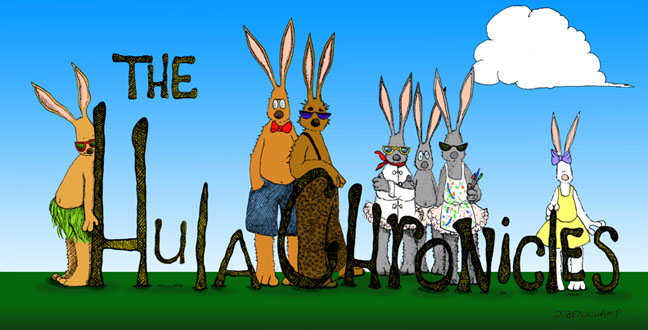While I’m happy to report that I’ve had a lovely season, full of good food and many reasons to be thankful, down at Rabbit Run things have been, shall we say, challenging. Now let me think, where was I?
As you may remember Charles Wallace arrived right in the middle of all the Thanksgiving cooking hullabaloo. And let me tell you, it was quite a sight. All the rabbits were bustling about except of course at that moment, Hula who was now asking Charles Wallace whether he preferred Oolong or Darjeeling, or perhaps he might care for Jasmine?
“Darjeeling please” said Charles Wallace.
Hula brewed up the water and got out two mugs. A yellow one and an aqua one.
“Oh,” said Charles Wallace with a small note of concern in his voice.
“Is something wrong?” asked Hula.
“Ah well,” said Charles Wallace looking sheepishly down at his feet. “That’s an awfully big mug and I am a rather small rabbit who only has so much room … do you have something smaller?”
Well dear friends, at this moment, if you were watching closely, you might have noticed a few whiskers stiffen in the room. Thelma cocked an eyebrow, and Harry pulled on his ear in what you might say was a pensive fashion. Because although Charles Wallace has many fine qualities – as all the rabbits are quick to admit – there are one or two, or possibly three, but certainly not four, things about him that can be, well… somewhat trying.
The first is that, although Charles Wallace is indeed a small fellow who, in his own words, “only has so much room,” the size of that room is open to debate amongst the other rabbits. The truth of the matter is that for such a small rabbit he can consume an astonishing amount of food. As Thelma has often pointed out “that little rabbit can tuck in.”
As a matter of fact on his last visit in the spring when Charles came out to help with the garden tilling, Chef Thelma had to double the recipe for Rabbit Paws in the morning, otherwise there wouldn’t have been enough for both the house and the café as Charles Wallace was having one while he was waiting for his tea, another with his tea and finally he would pocket two in his Osh Kosh overalls for a midmorning snack.
The second thing about Charles Wallace is, well, just take a listen and you’ll probably notice for yourself.
“…do you have anything smaller?” said Charles Wallace. “Perhaps a cup. Porcelain, if you have it, with a saucer. Darjeeling in a porcelain cup and saucer would be so civilized. By the way, would you happen to have any Darjeeling in loose leaf? Of course everyone knows that loose tea leaves are superior to most bagged tea because the leaf isn’t broken.”
“Of course a cup,” said Hula in a serious tone. This was not the first discussion she’d had with Charles Wallace on the merits of porcelain cups over the everyday ceramic mug but it was an easy one to forget. And no, the rabbits had no loose leaf Darjeeling. But Hula was able to find him a cup and a saucer although she was uncertain if it was porcelain.
“Of course a bigger tea leaf retains its natural oils and therefore its flavors, but,” he said brightly as Hula handed him his cup of tea, “I’m sure this is a superior brand of bagged tea.” Charles took a long sip, “Ah lovely,” he proclaimed and then he sighed, “This would be just heaven on Earth with a biscuit.”
Well the rabbits happened to have a few Rabbit Paws left over from breakfast, as Charles Wallace was secretly hoping and Hula quickly handed one to him and much to his delight, put the remainder on a plate. Charles Wallace took a bite and said, “The infamous Rabbit Paw: my tea is a perfect foil for the dryness of the afternoon biscuit."
“Well they were fresh this morning!” snapped a slightly put-upon Thelma.
“And it is my loss they I didn’t arrive sooner Chef,” said Charles Wallace in all earnestness.
Charles Wallace is a very decent, hardworking and in most ways thoughtful little rabbit but he is alas a real know-it-all, or as Beatrix once said in a moment of frustration: “Charles Wallace is a know-it-all who doesn’t know it all!”
And so it was that all the rabbits in the kitchen that morning were just a little tingly-pawed, hoping for a happy visit but just the tiniest bit concerned that the smooth operation and bonhomie of Rabbit Run might be thrown askew by the well-meaning, but occasionally irritating guest.
Hula wisely ushered Charles Wallace out to the front step of Rabbit Run were they sat down to sip their tea and eat their rabbit paws. There in the gentle sunlight of that cool November afternoon they struck their bargain. Charles Wallace would tend to the kitchen floors and Hula Bunny would mentor him in her capacity as a professional muse.
And this dear reader is where we will leave off our story for today. But trust me when I tell you, it is but the beginning of the saga of Charles Wallace’s visit for the holidays.









